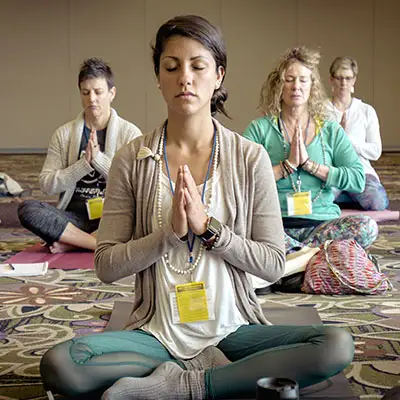Do you feel burned out from work? Do you catch yourself saying, more than you’d like, “If I could just get away for a while …"? Is a change in order but you aren’t quite sure which new direction to take? Then a gap year might be for you.
An adult gap year is more realistic than you realize, even if you have a family and maybe even if you aren’t sure you can afford it. Here’s everything you need to know so you can hit the refresh button and come back feeling more focused, creative, and ready for anything.
What Is a Gap Year?
A gap year is an opportunity for new experiences. Traditionally, it’s a semester or year after high school graduation but before beginning secondary education when students gain broader and deeper understanding of themselves and the world in which they live.
Travel is often a key aspect of a gap year. The person is encouraged to step outside their comfort zone to try new things for personal and professional development, and what better way to do that than to explore new places full of unfamiliar people and customs.
Is a Sabbatical the Same as a Gap Year?
Think of a sabbatical as a gap year for those no longer in school. Most of us are familiar with college professors taking sabbaticals. They typically use this time to take a break from teaching and focus instead on research.
Companies outside academia are starting to catch up to the idea of offering sabbaticals for their employees. During this time, which could be a few months or a full year, the employee is no longer responsible for their everyday duties. Instead, they use their time away from the office to pursue training or other interests that can benefit their careers.
In this sense, a sabbatical is very similar to a gap year. Both “breaks” offer the person the opportunity for personal growth and professional development while taking a structured hiatus from their regular responsibilities.
Can You Take a Gap Year as an Adult?
Absolutely! Adult gap years are becoming more popular for a few reasons: more companies recognize the benefits of offering their employees sabbaticals and the pandemic caused a lot of us to reprioritize what we want from our personal and professional lives.
In some ways, a gap year can be more challenging as an adult than as a young person. We may have families to consider, be afraid of jeopardizing an established career, or believe the myth that we’re “too old” to learn new tricks.
In other ways, however, an adult gap year can be easier. We might have greater financial stability, making time away from responsibilities more fiscally possible. We might also have greater perspective, which can help us steer our sabbaticals in a more focused way, resulting in greater personal benefit.
Do I Need to Take a Year Off Work for a Gap Year?
The idea behind a sabbatical is to take a break from your responsibilities, but that doesn’t mean you have to be unemployed during your gap year. If your employer offers paid leave — more on that in a minute — take advantage of it. It saves you a load of financial stress during your gap year, and you know you’ll have a job to come back to.
But what if your job doesn’t allow for a sabbatical, paid or otherwise? You have options.
- Ask for a transfer. Multinational companies will have offices in other countries. Look into taking a position abroad, even if (maybe especially if) it means your role changes, too.
- Use your gap year to transition to a new career. If you’re taking an adult gap year because your current job isn’t fulfilling anymore, this can be a great time to re-evaluate what you want professionally. Use this opportunity to strategize your next steps and come back refreshed for your next career adventure.
- Go the digital nomad route. With the expansion of remote work, it’s easier than ever to work from the road. It’s not the same as getting a sabbatical break, but the change of scenery and similar opportunities for exploration will be similar to taking a gap year.
- Try freelancing. Again, it’s not quite a break, but if your industry allows for freelancing, this can be a great way to make some extra cash while you travel. Freelance or consulting work could give you the schedule flexibility you need to explore those growth opportunities, too, unlike if you’re expected to be at a desk for eight hours per your boss’s instructions.
- Pick up jobs on the road. This tip is even more relaxed than freelancing. Think about what you’re good at — not just professionally, but personally as well — and offer your services as you travel. You might be able to tutor English in Japan, housesit in the Alps, or work on an alpaca farm on the Argentine Altiplano. This type of alternative tourism probably won’t pay all your bills, but again, it offers some flexibility for your gap year endeavors while letting you earn a bit of extra spending money.
How to Plan a Gap Year
Regardless of your age and specific situation, taking a gap year requires some planning. Remember, this isn’t a vacation. At the end, you want to have something to show for it, whether it’s a new item on your resume, an improved mental outlook, or the knowledge that you handled your gap year of travel with confidence and poise.
Investigate your employer’s sabbatical policies.
More companies are offering sabbaticals than in previous decades, but overall, the number is still relatively small. If your employer does offer leave for a gap year, dig into the logistical details. How long do you have to work there before you’re eligible? Will you still get a salary during your sabbatical or is it unpaid leave? What about benefits like health insurance?
Set goals for your sabbatical.
Like we said, a sabbatical isn’t a vacation. Decide what you want to get out of your adult gap year. Do you want to learn a specific skill like computer coding or leadership that can help you grow your career? Do you want more of a restful break to pursue creative interests like painting or meditation practices?
It’s easy to think that a professionally focused sabbatical has to result in a new certificate or degree, but don’t discount the mental and emotional benefits a sabbatical can offer simply by giving your mind a chance to focus on something different. Think of it as a way to combat burnout.
Decide if you'll go solo or take a travel companion.

The more people who come, the more planning it requires. Does the friend who’s coming with you need to work while you’re on sabbatical? Will you find a new school for the kids or home school them from the road? Many of these considerations are similar to if you were going to be a long-term digital nomad.
Consider annual travel insurance to protect your financial investment in your travel plans.
Travel insurance is a smart decision for any trip. When you’re on the road long term, however, it can be even more important.
If you’re traveling internationally, remember that your domestic health insurance might not cover you outside your home country. Seven Corners Travel Medical Insurance can offer protection if you get sick or hurt while traveling.
One more thing to consider: will you travel constantly for a year or take several smaller trips? There are different travel insurance options depending on your answer. For example, Seven Corners Travel Medical Insurance coverage is extendable for a total of up to 364 days.
On the other hand, if you’re planning several shorter trips, consider Seven Corners Travel Medical Annual Multi-Trip. With this plan, you purchase coverage once a year and then travel as often as you like. Customize your coverage by selecting your trip length, choosing from 30-, 45-, and 60-day trip lengths.
Create a budget.
Once you know whether your employer will keep paying you, what you want to do during your gap year, and where you want to do it, you’ll be better able to figure out what your travel expenses will be.
Also factor in any expenses you will still have at home. Do you have a mortgage or rent you’ll continue to pay? Will you hire a house sitter? Do you have to make arrangements to board or rehome a pet? Do you have debt you need to pay down?
How Much Money Do I Need to Save for an Adult Gap Year?
Travelers have reported spending as little as $5,000 and as much as $40,000 per person during their adult gap year. How much you need to spend before your own sabbatical will be affected by a variety of factors.
- Location: Some destinations are more expensive than others. Some of the cheapest gap years tend to be in Southeast Asia and could be accomplished with a budget of about $50 per day. If you’re planning on someplace like Italy, though, you’re going to need a bigger daily allowance.
- Timing: Similar to when you take a vacation, traveling during peak season will be more expensive than during off- or shoulder season. If your gap year plans include multiple smaller trips with periodic returns home, try to schedule those trips at less expensive times.
- Accommodations: Booking a vacation rental, staying at a hotel, or working for your room and board will all impact your budget differently. There are ways to save money on lodging without shacking up in a hostel with travelers half your age.
- Transportation: If you plan to destination hop or use one location as the hub you explore out from, think about the best way to get from one place to another during your gap year. Trains will be less expensive than planes. The cost of renting a car will vary more widely depending on where you are and the price of gas.
- Activities: If you sign up for a seminar or training course, most of your activity expenses might be paid upfront. But if you plan to explore more fluidly, your expenses might be spread throughout the trip. If your activities will be more day-to-day, factor in how much you’re willing to spend for each activity, remembering that even if admission fees are small, they can add up over time.
- Essentials: Food, clothing, and housing are one kind of essential. Visas and vaccines are another. Most countries will have their own visa and evisa processes and fees as well as health requirements. Research what those are before you board a flight.
Best Adult Gap Year Ideas
Sometimes we know we need something different, but we don’t know what should change. Your trip should be uniquely personal. It’s all about your own discovery and growth, after all. To get you started though, we put together a short list of our favorite travel ideas for an adult gap year.
- Train at a yoga retreat in Goa, India
- Enroll in foreign language classes … anywhere
- Start a memoir or finish your WIP (Work In Progress, for non-writers out there) at a residential writing retreat in Yorkshire, England
- Study photography or art in Venice, Italy
- Tackle wildlife conservation in Ecuador
- Learn to scuba dive in Bali
Don't Let a Gap in Coverage Derail Your Gap Year.
Gap years can look very different from one person to the next, so your travel insurance should protect the trip you’re taking and not just be a one-size-fits-all afterthought. Contact our licensed insurance agents to find the best travel insurance for your adult gap year or get a quick quote online using our interactive guide.
Travel Like a Pro with The Wayfinder
Did you enjoy this blog? Get more articles like it before anyone else when you subscribe to our monthly newsletter, The Wayfinder.
Sign me up


